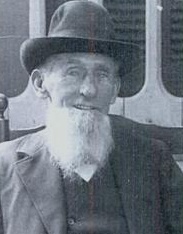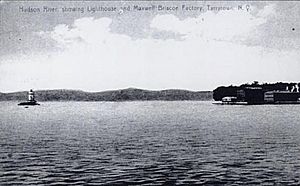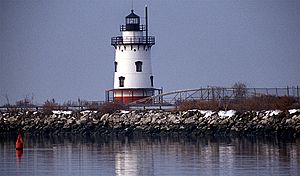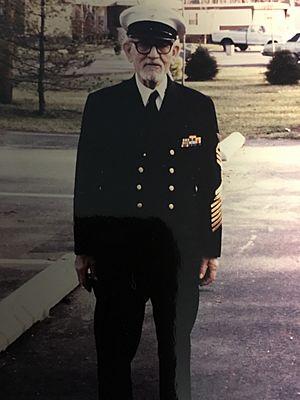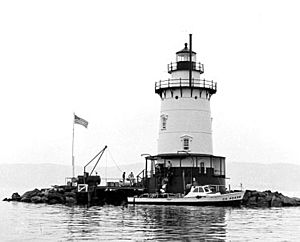Tarrytown Light facts for kids
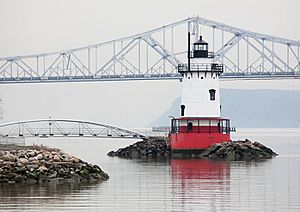 |
|
| Lighthouse and old Tappan Zee Bridge, 2011 | |
|
|
|
| Location | Hudson River south of Kingsland |
|---|---|
| Coordinates | 41°5′2.6″N 73°52′27.3″W / 41.084056°N 73.874250°W |
| Year first constructed | 1883 |
| Year first lit | 1883 |
| Automated | 1957 |
| Deactivated | 1961-2015 |
| Foundation | Stone Pier/Cast Iron Caisson |
| Construction | Cast Iron |
| Tower shape | Conical |
| Markings / pattern | White w/ Black trim and red base |
| Height | 60 feet (18 m) |
| Focal height | 56 feet (17 m) |
| Original lens | Fourth Order Fresnel lens |
| Intensity | 7000 cp (1883–1957) 1500 cp (1957–61) |
| Range | 13 nautical miles (24 km; 15 mi) |
| Characteristic | F. W (1883–94) F. R (1894–1902) Fl. R (1902–61) |
| Fog signal | Bell 20s, later 30s |
| Admiralty number | J1138.15 |
| ARLHS number | USA-836 |
The Tarrytown Light, also called the Kingsland Point Light or Sleepy Hollow Light, is a special kind of lighthouse. It stands on the east side of the Hudson River in Sleepy Hollow, New York. This lighthouse looks like a tall, round steel tower. It was built in the 1880s. In 1979, it was added to the National Register of Historic Places, which means it's an important historical site.
People realized by the mid-1800s that a lighthouse was needed. It would warn ships away from dangerous shallow areas near Tarrytown and Ossining. But land was expensive, so the government built the lighthouse about half a mile offshore. It was the only lighthouse on the lower Hudson River where a whole family could live inside. It was also the only lighthouse in Westchester County.
The lighthouse was used until the mid-1900s. The Tappan Zee Bridge was built right on the shallow areas the lighthouse warned about. Also, a General Motors plant was built nearby on land created from the river. These changes made the lighthouse no longer needed. Today, it's part of a county park, and you can even take tours inside.
Contents
Exploring the Tarrytown Lighthouse Building
The lighthouse is located just off the riverbank. It's at the south end of Kingsland Point Park. A 100-foot (30 m) walking bridge connects it to the shore. There's also a riprap breakwater (a wall of rocks) to protect it. Next to the lighthouse was once a large General Motors car plant.
The lighthouse itself is a five-story, cone-shaped building. It sits on a strong base made of stone and cast iron. This base holds a concrete cylinder that helps keep the lighthouse steady in the river. The outside is made of welded steel plates. The bottom is red, the tower is white, and the top lantern room is black.
There are windows on the second and third floors. The fourth floor has round porthole windows. The very top, the lantern room, has clear glass all around. A walkway with a roof goes around the first floor. This is where you enter the lighthouse. There are two more walkways higher up, one on the fifth floor and one around the lantern room. A flagpole stands on the fifth-floor walkway.
Inside the Lighthouse: A Home on the Water
When you go inside, you enter the main living area. This was an 18-foot-wide (5.5 m) living room and kitchen. Above this, the second and third floors were bedrooms, each about 15 feet (4.6 m) wide. The inside walls are covered in brick to keep the rooms warm.
The fourth floor is empty now. It used to have a bedroom and a workshop. Its ceiling has glass pieces to let light from the lantern shine down. From this floor, a ladder leads up to the watch area and the lantern room. The heavy 1,000-pound (450 kg) fog bell is still there, but it no longer works. In the basement, you can find the old coal shed and a cistern (a tank for collecting water). A central pole inside the lighthouse held the cables and a 50-pound (23 kg) weight that made the lantern spin.
History of the Tarrytown Light
People have used the Hudson River for travel for a very long time. Even before Europeans arrived, Native Americans knew about the dangerous shallow areas. As more ships used the river, the need for lighthouses became clear. It took a long time to find the right spot for this lighthouse. The Tarrytown Light was used until the Tappan Zee Bridge was built, which made it less important.
Early Days: Why Lighthouses Were Needed
Native American tribes living along the Hudson River used it for trade. They knew about tricky currents and hidden shallow spots. They would light bonfires on the shore to warn others. Later, European settlers used the river for trade too. First sailing ships, then steamships, carried goods and people between New York City and Troy.
River travel grew a lot in the 1820s. This was because of canals like the Erie Canal and the Delaware and Hudson Canal. These canals connected the East Coast to the Midwest and brought coal to New York City. Even with railroads later on, river shipping stayed important.
To help ships, 14 lighthouses were built along the Hudson River. Six of them, besides Tarrytown Light, are still standing today. The shallow areas near Tarrytown and Ossining were very dangerous. Sailors often preferred to use that side of the river. In 1847, a spot for a light was picked at Teller's Point. But the owner of the land wanted too much money. Another spot near Tarrytown was chosen, but its owner also asked for a high price.
While they looked for a spot, a red buoy marked the dangerous shallow area. Finally, the current offshore location was chosen. Building began in 1882 and cost almost $21,000. Stones were piled up for the base, and a boat dock was built. The lighthouse parts were made somewhere else and brought by boat. Workers put the 60-foot-tall (18 m) lighthouse together using anchored boats and scaffolding.
This lighthouse would be the only one in Westchester County. It was also the only steel lighthouse on the Hudson River where the keeper and their family could live inside the tower itself. When it was first lit, its white lantern had a special Fresnel lens. People said its light could be seen up to 15 nautical miles (28 km) away.
Active Years: 1883 to 1961
The Tarrytown Light was officially lit in 1883. Even though it was in North Tarrytown (now Sleepy Hollow), it was always known as Tarrytown Light on maps. Jacob Ackerman, a retired ship captain, was the first of ten lighthouse keepers. He worked there until 1904 and saved 19 lives during that time.
In 1894, the light's color was changed from white to red. In 1902, it was changed again to a flashing red light. The lighthouse building itself didn't change much until the 1940s. That's when modern bathrooms were added. In 1947, electricity was installed, so they didn't need kerosene lamps anymore. Later, the old coal heating system was replaced with modern heating.
Deactivation and Preservation: 1961 to Today
Around the same time, the Tappan Zee Bridge was built. One of its piers had its own lights. This pier was on the same shallow areas the lighthouse warned about. This meant ships were guided away from the shoals by the bridge lights. The United States Coast Guard made the lighthouse automatic in 1957. They also made the flashing red light less bright.
Two years later, the need for the lighthouse became even less. General Motors filled in the area between the lighthouse and the shore to make its car plant bigger. In 1961, the lighthouse was officially turned off.
But the lighthouse stayed. In 1974, the county got permission to build a walking path from Kingsland Point Park to the lighthouse. They built the path and a small bridge the next year. This allowed people to walk to the lighthouse. The county also bought the lighthouse itself. Today, tours are sometimes offered. On June 10, 2015, the lighthouse was lit up again in a special ceremony. It now has a new replica of its original lens.
Life as a Lighthouse Keeper
Early lighthouse keepers like Jacob Ackerman lived a simple life. They wrote down the weather, maintenance, and any important events every day. The United States Lighthouse Service collected these logs each month. Later, the United States Coast Guard took over this job. William Osborne Sininger and his family were the first Coast Guard family to live in the lighthouse.
The lighthouse was heated by a coal furnace. Water for bathing and drinking was collected from rain off the roof and stored in the basement cistern. Coal for the furnace was brought by boat. Keepers had to get all their food from land. They would boat to Tarrytown or, in winter, walk across the ice. This could be dangerous. For the first 60 years, the lighthouse had no electricity other than for the lantern and fog bell. All other lights came from kerosene lamps.
In 1943, Laurent LeClerc moved in with his wife and three children. During their time, the lighthouse got more modern things. These included household electricity, running water, and modern forced air heating.
The last keepers of the Tarrytown Light were the Moreland family. In 1955, Richard Moreland, a 20-year-old Coast Guard recruit, was given the job. He moved in with his new wife, Agnes. She was an Irish immigrant who loved lighthouses from her home country. They lived there for two years before the lighthouse became automatic. During that time, they had two daughters.
The Morelands talked to reporters about living in the lighthouse. It was still half a mile from the nearest land. The Coast Guard brought them water, so they didn't need the cistern as much. But they still kept it full. They had to go to land every two days for milk and bought groceries every two weeks. The couple could never leave the lighthouse together. One of them always had to stay there. Once, during a power outage, Richard Moreland hung an emergency kerosene lamp in the lantern. He also rang the fog bell himself.
Besides being isolated, they found it hard to fit normal, straight furniture against the curved walls. For fun, they mostly watched television or fished from the front door. Richard Moreland sometimes swam in the river. He tied a rope around his waist so the currents wouldn't carry him away. He said it was the best job in the Coast Guard because he didn't have to pay for housing.
Images for kids



